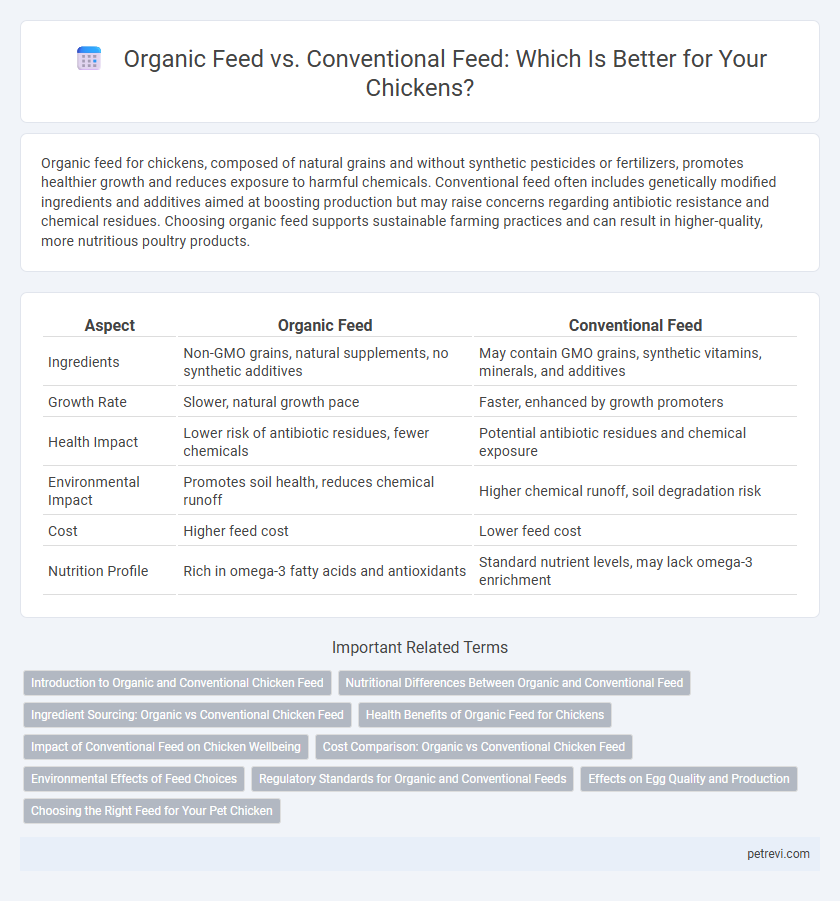Organic feed for chickens, composed of natural grains and without synthetic pesticides or fertilizers, promotes healthier growth and reduces exposure to harmful chemicals. Conventional feed often includes genetically modified ingredients and additives aimed at boosting production but may raise concerns regarding antibiotic resistance and chemical residues. Choosing organic feed supports sustainable farming practices and can result in higher-quality, more nutritious poultry products.
Table of Comparison
| Aspect | Organic Feed | Conventional Feed |
|---|---|---|
| Ingredients | Non-GMO grains, natural supplements, no synthetic additives | May contain GMO grains, synthetic vitamins, minerals, and additives |
| Growth Rate | Slower, natural growth pace | Faster, enhanced by growth promoters |
| Health Impact | Lower risk of antibiotic residues, fewer chemicals | Potential antibiotic residues and chemical exposure |
| Environmental Impact | Promotes soil health, reduces chemical runoff | Higher chemical runoff, soil degradation risk |
| Cost | Higher feed cost | Lower feed cost |
| Nutrition Profile | Rich in omega-3 fatty acids and antioxidants | Standard nutrient levels, may lack omega-3 enrichment |
Introduction to Organic and Conventional Chicken Feed
Organic chicken feed consists of natural ingredients grown without synthetic pesticides, fertilizers, or genetically modified organisms (GMOs), ensuring higher nutritional quality and environmental sustainability. Conventional feed typically includes genetically modified grains, synthetic additives, and chemical fertilizers, which may promote faster growth but raise concerns about residue and long-term health effects. The choice between organic and conventional feed impacts chicken health, product quality, and consumer preferences in poultry production.
Nutritional Differences Between Organic and Conventional Feed
Organic feed for chickens typically contains higher levels of omega-3 fatty acids and antioxidants due to the absence of synthetic pesticides and fertilizers, promoting enhanced nutritional quality in the meat and eggs. Conventional feed often includes genetically modified organisms (GMOs) and synthetic additives, which may affect nutrient absorption and overall bird health. Studies highlight that organic feed improves the lipid profile and increases vitamins such as E and A in chicken products compared to conventional feed.
Ingredient Sourcing: Organic vs Conventional Chicken Feed
Organic chicken feed derives from crops grown without synthetic pesticides, herbicides, or fertilizers, ensuring non-GMO and chemical-free ingredients that support animal health and product quality. Conventional feed often includes genetically modified grains, synthetic additives, and may contain residues from chemical treatments, potentially impacting the nutritional profile of the chicken. Ingredient sourcing in organic feed prioritizes sustainable farming practices and certified organic standards, enhancing the overall safety and environmental footprint of poultry production.
Health Benefits of Organic Feed for Chickens
Organic feed for chickens, composed of non-GMO grains and free from synthetic pesticides, enhances poultry health by reducing exposure to harmful chemicals and promoting stronger immune systems. Chickens consuming organic diets often demonstrate improved growth rates, better egg quality with higher omega-3 fatty acids, and lower incidences of diseases compared to those fed conventional feed. This natural nutrition supports sustainable farming practices and contributes to healthier poultry products for consumers.
Impact of Conventional Feed on Chicken Wellbeing
Conventional feed for chickens often contains synthetic additives, antibiotics, and genetically modified ingredients that can negatively impact their overall wellbeing. This type of feed may contribute to increased stress levels, weakened immune systems, and higher susceptibility to diseases in poultry. Research shows that chickens consuming conventional feed tend to exhibit lower growth quality and reduced lifespan compared to those raised on organic diets.
Cost Comparison: Organic vs Conventional Chicken Feed
Organic chicken feed typically costs 30-50% more than conventional feed due to higher ingredient quality and certification expenses. Conventional feed relies on synthetic fertilizers and pesticides, making it more affordable but less sustainable. Despite the higher initial expense, organic feed can improve chicken health and market value, potentially offsetting cost differences over time.
Environmental Effects of Feed Choices
Organic feed for chickens typically reduces environmental impact by minimizing synthetic pesticide and fertilizer use, which lowers soil and water contamination. Conventional feed often involves intensive farming practices associated with higher greenhouse gas emissions and greater resource consumption. Choosing organic feed supports sustainable agriculture, promoting biodiversity and enhancing ecosystem health.
Regulatory Standards for Organic and Conventional Feeds
Organic chicken feed strictly adheres to USDA National Organic Program standards, requiring non-GMO ingredients, no synthetic pesticides, and no antibiotics or growth hormones, ensuring higher natural content and environmental sustainability. Conventional chicken feed regulations, governed by the FDA and state agencies, permit synthetic additives, antibiotics, and genetically modified organisms to promote growth and prevent disease, with a focus on cost-effectiveness and production efficiency. Compliance with these regulatory frameworks affects nutrient profiles, animal welfare, and market labeling, influencing consumer choice and feed formulation strategies in poultry farming.
Effects on Egg Quality and Production
Organic feed for chickens, rich in natural grains and free from synthetic pesticides, improves egg quality by enhancing yolk color and increasing omega-3 fatty acid content. Conventional feed, often composed of genetically modified ingredients and antibiotics, may promote faster growth and higher egg production but can compromise nutritional value and shell strength. Studies show organic feed supports healthier hens, resulting in eggs with superior taste, texture, and nutritional profile, making it a preferred choice for high-quality egg production.
Choosing the Right Feed for Your Pet Chicken
Organic feed for pet chickens offers a diet free from synthetic pesticides and fertilizers, promoting healthier growth and better egg quality compared to conventional feed. Conventional feed often contains genetically modified ingredients and additives, which may impact the chicken's digestive health and overall well-being. Selecting organic feed supports natural nutrient absorption and reduces exposure to harmful chemicals, making it a preferable choice for maintaining a robust and healthy pet chicken.
Organic Feed vs Conventional Feed for Chicken Diet Infographic

 petrevi.com
petrevi.com